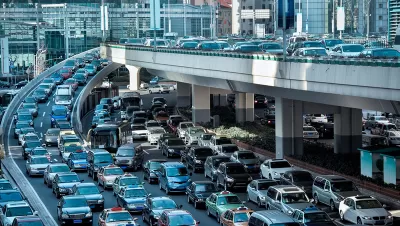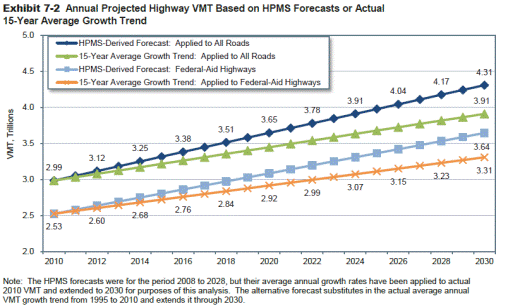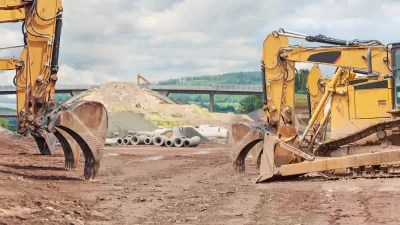The “Status of the Nation’s Highways, Bridges, and Transit: Conditions and Performance, Report To Congress” is intended to provide a comprehensive and objective evaluation of our transportation system. Let’s evaluate this evaluation.

The Status of the Nation’s Highways, Bridges, and Transit: Conditions and Performance, Report To Congress (C&P) is intended to provide decision-makers with an objective appraisal of the physical conditions and operational performances of highways, bridges, and transit systems, and their future under various investment scenarios. This is the tenth such report.
Although the C&P is intended to be an objective and detailed assessment, its unstated intent is to justify investments in transportation infrastructure, so its basic narrative is that traffic congestion is a major problem and major investments are needed to accommodate future traffic growth. It provides information to support this narrative and little critical analysis that challenges these assumptions. This is the first report that is forced to confront evidence of fundamental changes in travel demands, including peaking of automobile travel, increased demand for alternative modes, and an expanded scope of planning objectives. It is starting to change, but retains some significant omissions and biases.
Previous editions of this report assumed that vehicle miles traveled (VMT) would grow at 1.85% annually (called Forecast VMT Growth). However, automobile travel peaked in 2006 and has declined slightly since, and many of the demographic and economic factors that contribute to this decline are unlikely to reverse. As a partial recognition of these trends the analysis now includes a somewhat lower, 1.37% annual scenario (called Trend VMT Growth), as illustrated below.
C&P Projected Vehicle Travel Growth

This graph shows the C&P’s assumptions that U.S. vehicle travel will grow from about 3.0 billion to between 3.91 and 4.31 billion VMT by 2030.
But even this seems much too high for a realistic lower-bound growth rate. The graph below compares actual VMT trends with what was projected by various C&P reports; the newest edition continues to assume that vehicle travel will grow significantly in the future. These growth values significantly affect the C&P's projected future traffic congestion problems and roadway expansion benefits.
Projected And Actual Vehicle Travel Growth

This graph illustrates actual and projected VMT trends.
Despite seven years of flat VMT, the U.S. continues to invest more than $25 billion annually in highway expansion, which is similar to spending levels during past periods of rapid VMT growth. By assuming that vehicle travel will continue to increase in the future, the C&P justifies continued high levels of spending on roadway expansion and discourages shifting these resources to other types of transportation system improvements.
For example, the Report estimates (p. CO-18) that improving roadway performance would cost $145.9 billion under the higher projected growth rate but only $123.7 under the 9% lower VMT growth projection, a $22.2 billion cost reduction which could be considered potential savings provided by transportation demand management strategies that reduce VMT. The potential highway cost savings ($22.2 billion) are far greater than the additional funds required to meet the study’s higher transit ridership growth scenario (about $8 billion).
Described differently, the C&P assumes that future travel patterns (how and how much people travel) are uncontrollable, ignoring the impacts of policy and planning decisions. Yet, many transport policies and planning decisions create self-fulfilling prophecies: if we assume that VMT will grow and so continue to invest in roadway expansions and maintain policies that keep driving relatively cheap (low fuel taxes and production subsidies, high minimum parking requirements in zoning codes, etc.), VMT will grow, but if we put the same resources into improving alternatives (improving walking, cycling and public transit, and creating more affordable transit-oriented communities) VMT will grow less or not at all.
The Report includes a section titled, “Number One Issue for the Public: Price of Travel” (p. 1-17) which discusses responses to a National Household Travel Survey question concerning the most important transportation issue, which ranked the “Price of travel” highest, much higher than congestion or safety. This is an important issue, but the C&P Report focuses on fuel prices, reflecting an automobile-oriented perspective, although fuel is only 20-25% of total transportation costs. A more comprehensive and multi-modal perspective would also consider user demands for more affordable travel modes (walking, cycling and public transit) and smart growth development patterns. There is now good research indicating that residents of such communities spend significantly less on transportation than residents of more automobile-dependent communities.
Although the Report discusses the importance of comprehensive economic evaluation (p. II-6), and mentions various impact categories (“Benefit-Cost Parameters Data Table,” p. C-3), it does not clearly identify how these impacts are used in its economic models, and I was unable to find more detailed technical documentation. The table below summarizes the impacts that appear (as far as I can tell) to be included and overlooked. Many of the overlooked impacts are potentially large in magnitude, and are likely to become more important in the future, so their omission undervalues transit investments. For example, the analysis seems to assume that wider roads reduce crash rates, although this is not necessarily true, and ignores the safety benefits provided by transportation demand management strategies such as public transit improvements and pricing reforms. Similarly, although it seems to include user-paid parking costs that are reduced when commuters shift from automobile to alternative modes, it ignores the savings to businesses if their employers reduce automobile parking demand, and residential parking cost savings provided by reduced household vehicle ownership rates.
|
Included |
Overlooked |
|
Transit passenger travel time savings Transit passenger reduced vehicle operating costs Transit passenger reduced accident cost Transit passenger avoided vehicle parking fees Reduced congestion, air pollution and road wear from reduced vehicle travel |
Improved mobility for non-drivers Transit passenger comfort benefits (e.g., from reduced crowding) Vehicle ownership cost savings (?) Parking subsidy cost savings to businesses Reduced per capita crash risk (particularly from transit-oriented development) Reduced impervious surface and stormwater management costs from reduced parking and more compact development |
The O&P’s economic evaluation framework only considers a limited set of transit benefits. Many of the overlooked benefits are potentially large in magnitude, and are likely to become more important in the future.
In the “Economic Competitiveness” chapter, the Report argues that traffic congestion has an adverse impact on the American economy, and that “Inadequate Physical Capacity” is the largest single cause of congestion, implying that roadway expansion is the most effective transport investment to support economic development. There is actually considerable debate concerning the degree that traffic congestion reduces economic productivity. Most congestion delays are for personal travel which does not directly affect economic productivity; commercial travelers are pretty good at avoiding congestion, for example by scheduling freight trips during off-peak periods. The empirical evidence actually indicates that more economically productive areas tend to have more congestion. There is little evidence that expanding roadways is a cost-effective way to reduce congestion; other strategies, including grade-separated public transit, congestion pricing and transportation demand management programs, are generally more cost-effective overall.
The Report includes a section titles, “Myths and Facts About Daily Travel,” which argues that public transit is less important than most people think in serving disadvantaged populations (seniors and zero-vehicle households). I don't know anybody who claims that disadvantaged people rely entirely on public transport, but disadvantaged groups do rely on public transit much more than average. This section is a not-so-subtle form of editorializing intended to denigrate public transit.
Current changes in travel demands and policy goals require transportation agencies to fundamentally rethink their objectives and planning practices. This quote from The Economist describes how we can take advantage of peaking car travel. The C&P authors do not seem to have read this article.
"Even if they are not faced by an invasion of robo-taxis, governments may find that changes in driving habits force them to rethink infrastructure. Most forecasting models that governments employ assume that driving will continue to increase indefinitely. Urban planning, in particular, has for half a century focused on cars.
America built 64,000 kilometres (40,000 miles) of interstate highway to get the country moving after the second world war; since 1980 it has built more than 35,000 new lane-kilometres a year. If policymakers are confident that car use is waning they can focus on improving lives and infrastructure in areas already blighted by traffic rather than catering for future growth.
By improving alternatives to driving, city authorities can try to lock in the benefits of declining car use. Cars take up more space per person than any other form of transport—one lane of a freeway can transport 2,500 people per hour by car, versus 5,000 in a bus and 50,000 in a train."
For More Infomation
Eric Dumbaugh (2012), “Rethinking the Economics of Traffic Congestion,”Atlantic Cities.
FHWA (2012), Integrating Demand Management Into The Transportation Planning Process: A Desk Reference, FHWA-HOP-12-035, Office of Operations (www.ops.fhwa.dot.gov), Federal Highway Administration.
Todd Litman (2014), Toward More Comprehensive and Multi-modal Transport Evaluation, Victoria Transport Policy Institute.
Todd Litman (2013), “The New Transportation Planning Paradigm,”ITE Journal, Vo. 83, No. 6, pp. 20-28.
Michael Sivak (2012-2014), Has Motorization In The U.S. Peaked?, series,University of Michigan Transportation Research Institute.
Matthias Sweet (2013), “Traffic Congestion’s Economic Impacts: Evidence from US Metropolitan Regions,”Urban Studies, Vol. 50, No. 15;.
Eric Sundquist (2014), U.S. DOT Highway Travel Demand Estimates Continue To Overshoot Reality, State Smart Transportation Initiative.
TRB (2013),Review of the Federal Transit Administration’s Transit Economic Requirements Model, Transportation Research Board (www.trb.org).
USDOT (2013),Status of the Nation’s Highways, Bridges, and Transit: Conditions and Performance, Report To Congress, US Department of Transportation, Federal Highway Administration and the Federal Transit Administration.
USDOT Continues to Overestimate Future Vehicle Travel - When Will They Learn?, Planetizen.

Maui's Vacation Rental Debate Turns Ugly
Verbal attacks, misinformation campaigns and fistfights plague a high-stakes debate to convert thousands of vacation rentals into long-term housing.

Planetizen Federal Action Tracker
A weekly monitor of how Trump’s orders and actions are impacting planners and planning in America.

San Francisco Suspends Traffic Calming Amidst Record Deaths
Citing “a challenging fiscal landscape,” the city will cease the program on the heels of 42 traffic deaths, including 24 pedestrians.

Defunct Pittsburgh Power Plant to Become Residential Tower
A decommissioned steam heat plant will be redeveloped into almost 100 affordable housing units.

Trump Prompts Restructuring of Transportation Research Board in “Unprecedented Overreach”
The TRB has eliminated more than half of its committees including those focused on climate, equity, and cities.

Amtrak Rolls Out New Orleans to Alabama “Mardi Gras” Train
The new service will operate morning and evening departures between Mobile and New Orleans.
Urban Design for Planners 1: Software Tools
This six-course series explores essential urban design concepts using open source software and equips planners with the tools they need to participate fully in the urban design process.
Planning for Universal Design
Learn the tools for implementing Universal Design in planning regulations.
Heyer Gruel & Associates PA
JM Goldson LLC
Custer County Colorado
City of Camden Redevelopment Agency
City of Astoria
Transportation Research & Education Center (TREC) at Portland State University
Jefferson Parish Government
Camden Redevelopment Agency
City of Claremont





























